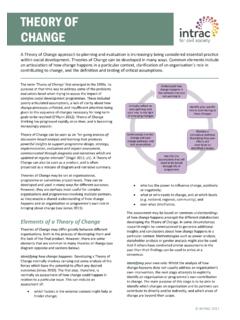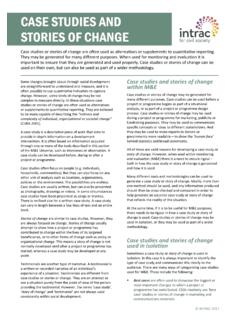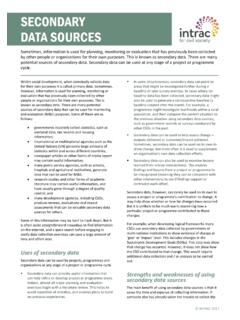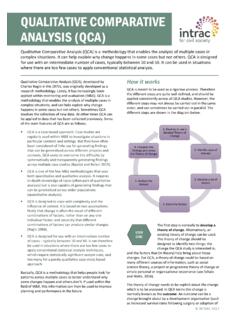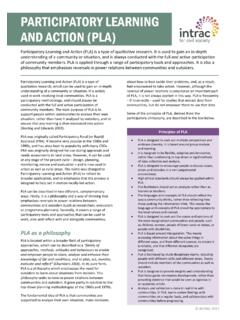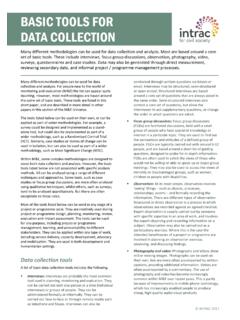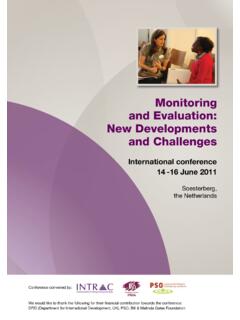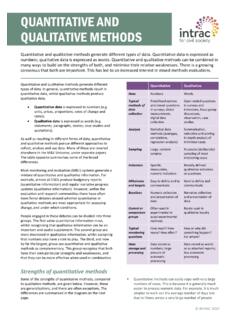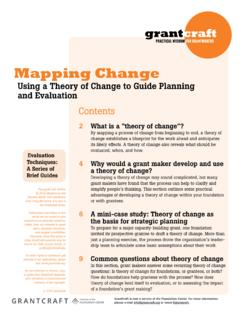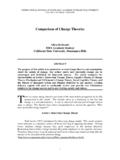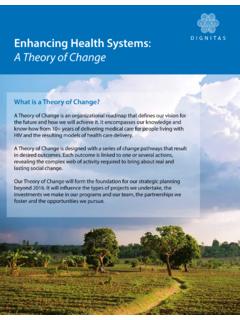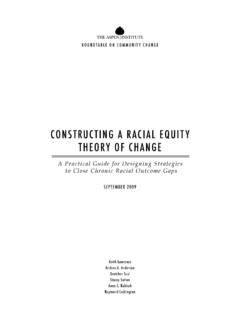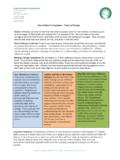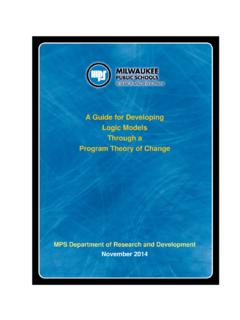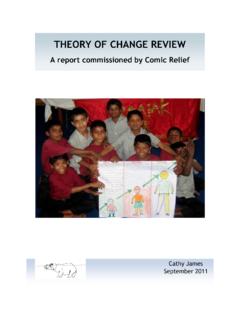Transcription of Theory of Change - INTRAC
1 Theory of Change INTRAC 2015 1 A Theory of Change approach to planning and evaluation is increasingly being considered an essential practice for many organisations, programmes and projects. Theories of Change can be developed in many different ways but there are often common elements. These include an articulation of how Change happens in a particular context, clarification of an organisation and its partners roles in contributing to Change , and the definition and testing of critical assumptions. The term Theory of Change first emerged in the 1990s. Its purpose at that time was to address some of the problems evaluators faced when trying to assess the impact of complex social development programmes.
2 These included poorly articulated assumptions, a lack of clarity about how Change processes unfolded and insufficient attention being given to the sequence of changes necessary for long-term goals to be reached (O Flynn, 2012). Theory of Change thinking has progressed rapidly since then, and is becoming increasingly popular. Theory of Change can be seen as an on-going process of discussion-based analysis and learning that produces powerful insights to support programme design, strategy, implementation, evaluation and impact assessment, communicated through diagrams and narratives which are updated at regular intervals (Vogel, 2012, p5). A Theory of Change can also be seen as a product, and is often presented as a mixture of diagram and narrative summary.
3 Theories of Change may be set at organisational, programme of sometimes project levels. They can be developed and used in many different ways for different purposes. However, they are perhaps most useful for complex organisations and programmes involving multiple partners, as they enable a shared understanding of how Change happens and an organisation or programme s own role in bringing about Change (see James, 2011). Elements of a Theory of Change Theories of Change may differ greatly between different organisations, both in the process of developing them and the look of the final product. However, there are some elements that are common to many theories of Change (see diagram) Identifying how Change happens Developing a Theory of Change would normally involve carrying out some analysis of the forces which have the potential to affect any desired outcomes (Jones, 2010).
4 The first step, therefore, is normally an assessment of how Change could happen in relation to a particular issue. This can include an assessment of: which factors in the external context might help or hinder Change ; who has the power to influence Change , positively or negatively; what or who needs to Change and at which levels ( national, regional, community); and over what timeframes. The assessment may be based on common understandings of how Change happens amongst the different stakeholders developing the Theory of Change . In some circumstances research might be commissioned to generate additional insights and conclusions about how Change happens in a particular context. Methodologies such as power analysis, stakeholder analysis or gender analysis might also be used.
5 And if others have conducted similar assessments in the past then their findings can be used to arrive at a consensus. Identifying your own role in the Change process Whilst the analysis of how Change happens does not address an organisation s own intervention, the next stage attempts to explicitly identify an organisation or programme s own specific contribution to Change . The main purpose of this stage is to be able to identify what changes both the organisation and its partners are able to contribute to directly and/or indirectly (bearing Theory of Change Theory of Change INTRAC 2015 2 in mind that for each organisation this will be different), and which areas of Change are beyond the scope of all participating organisations.
6 Developing a conceptual pathway Once there is clarity about the potential roles that different organisations can play, the next stage involves identifying an achievable long term goal, clarifying and identifying the key changes which need to be in place for this goal to be realised, and then discussing and agreeing for an organisation or programme: who it needs to work with and how; what changes in their knowledge, attitudes, skills and behaviour are required; and what activities or working approaches are needed to contribute to those desired changes. The results of these discussions are often presented as a conceptual map which illustrates the linkages between an organisation s work and the desired medium and long term changes it seeks to influence.
7 This can be done in different ways, but at present three types of conceptual process are most often used (Jones, 2010). 1. The most well-known conceptual pathway is the causal chain. It describes a succession of elements inputs, activities, outputs, outcomes, impacts with different elements in combination leading to the next element. Objectives trees and impact pathways are both types of causal chains. The causal chains can range from simple logic models, such as the ones contained in a logical framework, to much more complex flow charts and diagrams with arrows pointing in all directions. 2. Dimensions of Change can also be used. This involves developing areas or domains of Change that in combination are considered important in contributing to the desired goals.
8 Dimensions of Change are most likely to be used within broad, organisational Theories of Change that are meant to be applied in different contexts at different times. 3. Some conceptual pathways are designed to capture behavioural Change of different actors, based on the idea that actors and agency are a key driving force for Change . The most common method for applying this at the moment is Outcome Mapping, which helps organisations define desired changes in actors behaviour at different levels changes that a programme expects to see over its lifetime; changes it would like to see; and changes it would love to see and that would indicate long-term sustainable Change . In each case, the idea is to make explicit the kind of Change that an organisation or programme is seeking, and how the work it carries out helps support that Change at different levels.
9 In many (not all) cases the conceptual pathway also becomes a summarising diagram that can easily communicate the Theory of Change to different stakeholders. Identifying assumptions A critical part of Theory of Change thinking is the articulation of assumptions. Either at this point in the process, or in parallel with earlier stages, an organisation or programme develops a series of assumptions. These assumptions are often linked to specific places in the conceptual pathway, and can be seen as conditions that are seen as necessary for Change at one level to influence Change at another level. Theory of Change encourages the testing of these assumptions throughout an organisation or programme s work.
10 The combination of the conceptual pathway with its associated assumptions are what makes a Theory of Change analogous to a scientific Theory a Theory that can be tested and sometimes disproved, resulting in an amendment to the Theory , or sometimes its complete abandonment. Ongoing monitoring of Change Regular monitoring of Change forms an important part of Theory of Change thinking. Many organisations choose to link their monitoring and evaluation systems to their Theories of Change , either by setting indicators at each level of Change on their conceptual pathway or by attempting to assess Change directly (James, 2011). This enables organisations to assess where Change is happening, and where it is not happening, and to track whether or not they are making progress towards their longer-term goals or impact.


